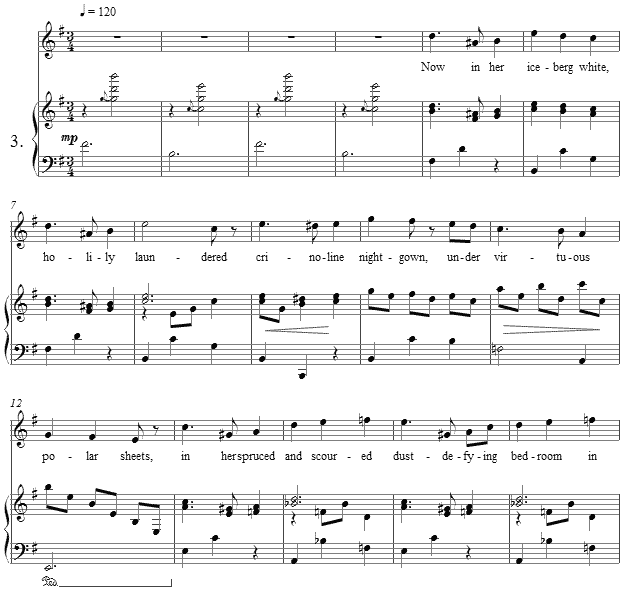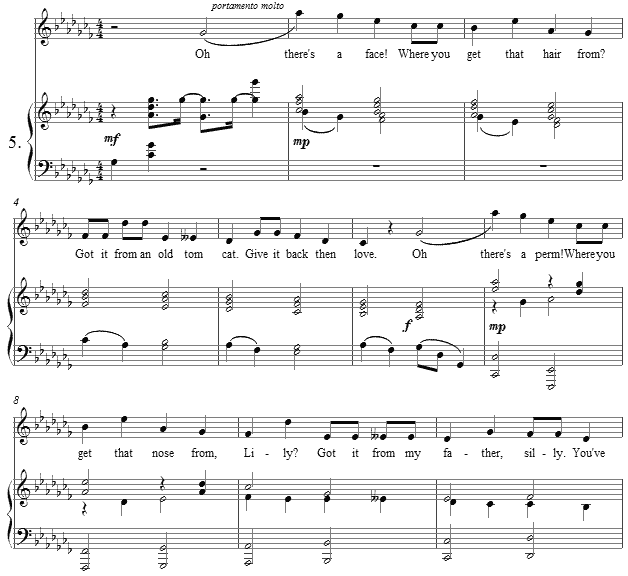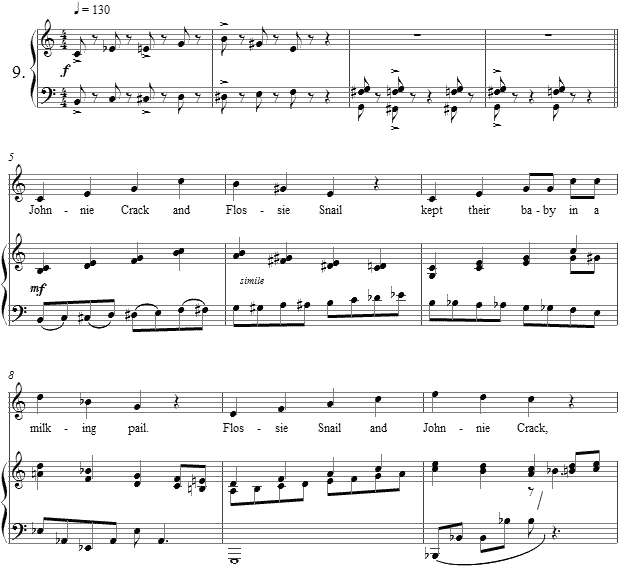Music and Texts of GARY BACHLUND Vocal Music | Piano | Organ | Chamber Music | Orchestral | Articles and Commentary | Poems and Stories | Miscellany | FAQs |
Voices Under Milk Wood - (1989)
Dylan Thomas
Fifteen songs for medium high voice and piano

Dylan Thomas
Under Milk Wood, the radio play by Dylan Thomas, remained under copyright throughout Europe until 2024. These songs were composed as sketches towards a chamber opera intended for a number of singers, and correspondence with the estate through the International Copyright Bureau proved ineffective at that time at gaining non-exclusive rights to edit the full text into a shorter libretto. At the time of corresponding with the estate, from 1991-92, the songs and some additional sketches were already composed to test the premise, and given by the composer at a free public recital at UCLA in that year and subsequently at private functions.
As of 2024, the works of Dylan Thomas have become in the public domain. One reads, ""Well-known works that entered the public domain in the UK on the 1st of January include the works of Dylan Thomas...." In "January 2024: new works in the public domain, good tidings for images, and a new year’s resolution," by Christina Daouti, University College London, 11 January 2024.
Therefore this short song cycle completed in 1989, and, soon, a larger setting of the play are being posted now.
DRAFT OF A RATIONALE
Summer 1991
Dylan Thomas' radio play, Under Milk Wood, entered this world a literary classic. Since his debut reading of it at the Y's Poetry center in New York City, the play has enjoyed repeated readings, airings, staged productions, audio recordings, and been filmed in a screenplay adaptation by Andrew Sinclair.
As with the body of Thomas' work, and in his own words, it is "prose [and poetry] with blood pressure."
In 1947, before Under Milk Wood, Thomas wrote in a letter to his parents about creating a libretto to a "full length grand opera for William Walton." (Ferris, Letters) That proposed collaboration never became a reality.
In 1953, Aldous Huxley, librettist for The Rake's Progress, suggested Thomas as librettist to Igor Stravinsky. An opera was to have been commissioned by Sarah Caldwell and the Opera Workshop of Boston University. In a letter to E. F. Bozman, Thomas foretold his upcoming success with the "Stravinsky libretto," as he called it. (Ferris, Letters) When the commission did not come, Stravinsky suggested they make "a start on their own" in Los Angeles. (Brinnin, Dylan Thomas in America) Thomas' death intervened.
Thomas' obvious interest in opera -- words in song -- as a medium for his work is easily documented in his own words. As to his ongoing plans for Under Milk Wood which were cut short by his death, composer and friend Daniel Jones wrote "the evening, like the morning, was to be 'all singing.'" (1974, "Second Preface" to Under Milk Wood) The quotes around "all singing" in Jones' Preface report Thomas' view, who was creating "ballads to be sung by some of the main characters."
Jones, Thomas' first literary executor and the original copyright trustee, supplied the songs for the play -- songs whose manuscripts are reproduced in New Directions Paperback editions. These song settings appear as a regular and integral part of recorded editions of the play -- one with Thomas as First Voice. As Jones tells us, more music was planned.
Under Milk Wood is words and words-with-music. Would Thomas have sanctioned the play's use as a libretto? I believe most certainly that he would.
We know certainly that more music was planned, but never added. And we know Thomas considered himself a potential librettist. Hence we may ask: was Under Milk Wood to be "all singing," as one of Thomas' longest and most trusted friends clearly writes? It is an obvious possibility.
My then unpublished song cycle, Voices Under Milk Wood, based on the play text, was written in 1989 during my work with Charles Mackerras and the Welsh National Opera, in Cardiff and on tour throughout south Wales and England. While living the summer in Wales, I became an ardent student of Thomas' work. While musical settings of his poetry might seem a more likely focus for art songs, it was the prose and poetry -- with blood pressure -- of Under Milk Wood [as an opera setting] which drew me.
I visited Swansea which knew Thomas' boyhood, the Pembroke of Mr. Waldo's song, the boat house over the estuary at Laugharne and the hillside graveyard where he now lies under a white-washed cross. These places, with the words of the play, were soil in which my settings are rooted.
.
The fifteen songs drawn from the play were intended as a cycle, as an homage to Thomas. The musical materials are directly melodic, words in the foreground, to make the characters speak more clearly.
Yet, the piece beckons, and, with Daniel Jones, I foresee it as "all singing."[ Addendum: Since 1991, while living and working in a number of countries, notably Germany, I added sketches to a file with the notion in mind to work further with Thomas' magical text. In 2015, Welsh-Canadian composer John Metcalf composed his operatic setting which has been performed. Work had begun in 2007, and then premiered at the Taliesin Arts Centre, Swansea in April 2014. My longer work will also simply be titled Under Milk Wood, and published shortly. I have fond recollections of my time in Cardiff with the Welsh National Opera, the rehearsals and performances of Ariadne auf Naxos under Charles Mackerras (1925-2010), in his time as WNO musical director, and Giles Havergal (b. 1938), stage director, whose interesting work with us performers in the cast was lovingly daft and inventive. Other fond memories include walking from our rehearsal facilities in the City Center north along either along Cathedral Road or through the park with the river Taff running through it, to my landlady, Mrs. Hobday, and her hospitality during my stay there. One weekend when she went to see her sister in Sussex, as a surprise and 'thank you' I painted her rusting iron fence at the front of that house on a warm weekend day in Cardiff. Funny the things one may recall. Llandaff Cathedral and the meadows nearby to that house whisper still. ]
THE SONGS
Written for for medium high voice and piano, the fifteen settings portray different characters and, while standing alone for a single performer in a recital setting, would be distributed among the players in a music theater setting. Most are songs for the character known simply as First Voice, a narrator. They are:
i.
ii.iii.
iv.
v.
vi.
vii.
viii.
ix.
x.xi.
xii.
xiii.
xiv.
xv.Title
First Voice
A Draper Mad With Love
Mrs Ogmore-Pritchard Widow
Bessie Bighead
Oh There's a Face!
Whispers on the Stairs
Mary Ann Sailors
Remember Last Night?
The Children's Song
Polly Garter (singing)
Knock Twice, Jack
A Puffball
Sunset Hymn
In Pembroke City
First Voice Last
Dates of Composition
28 V 1989
09 VII 1989
06 VII 1989
11 VII 1989
27 V 1989
22 V 1989
04 VI 1989
10 VI 1989
06 VI 1989
29 V 1989
28 V 1989 /
23 VI 1989
02 VI 1989
09 VI 1989
11 VI 1989
Place of Composition
Cardiff
Cardiff
Cardiff
Cardiff
Cardiff
Cardiff
Cardiff
Swansea
Cardiff
Cardiff
Laugharne
Southampton
Cardiff
Cardiff
Cardiff
The opening of the radio play begins with a narrator named First Voice. For this the "moonless" time before dawn is conjured in the rocking movement of a gentle accompaniment, and the narrator begins to describe the scene.
In this short cycle , a draper mad with love, is followed by a thumbnail sketch of one "Mrs. Ogmore-Pritchard Widow" who seems to completely cold and controlling that even her dead husbands must heed "she who must be obeyed." For this a waltz in B minor is chosen to set the text, in which the upper and lower neighbors are a musical pun to hint at the two dead husbands who she gathers to her side day and night.
After a small requiem for the lost love of the homely Bessie Bighead, an up tempo song brings on the uproarious and self-demeaning questions thrown into a mirror suggest that Lily is both in love and insecure, a truth of life which we should know well from some lesson in our own past.
After a snarling yet milquetoast of a husband brings tea to his wife in bed after his "Whispers on the Stairs," the narrator tells of the oldest of Milk Wood's inhabitants, Mary Ann Sailors. This simple setting relies for the most part on a six note "tone row," which in other web pages I have argued is as reasonable a pre-compositional strategy as the seemingly "de rigueur" twelve note row which became the "new" orthodoxy of the twentieth century, so proud of its escape from tonality that it fashioned a complete cage from which semiotically understood melody must be "liberated" by the new tonal resurgence among modern composers who are turning away from the "old" orthodoxy of the so-called Second Viennese school and its devotees.
This setting uses the row as defined in the first four notes of the melodic line, D, E, G and A and the inclusion in the accompaniment of B and C. Of course, by measure nine, even this tiny orthodoxy gives way to include the subtle flavor of the "new" B flat, which drives the harmony in common practice fashion to an F major harmony under the same recurrent four melodic notes.
"The Children's Song," also given to the narrator, involves seeming dissonances of parallel seconds and the chromatic bass line, and yet these features only serve to characterize the tonic C major as an apt setting for the child-like melody.
The score for Voices Under Milk Wood is available as a free PDF download, though any major commercial performance or recording of the songs are prohibited without prior arrangement with the composer. Click on the graphic below for this piano-vocal score.
Please note: The texts are in the Public Domain in the EU, Canada, Australia and New Zealand, non-PD in the US for now.



